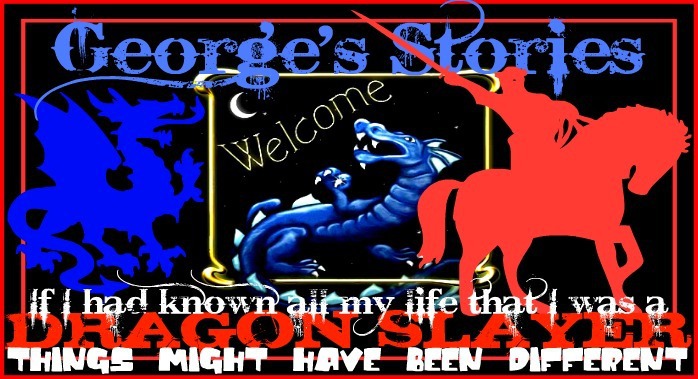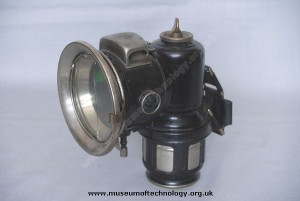A Trip Inside the Mine
A trip inside has to be made now in order to understand the cutting machine that was powered by the DC generator.
It started at the entrance of the slope---walking between the tracks---the sides and roof lined with boards, supported by railroad ties. As you walked, the daylight receded, leaving only the light provided by the carbide miner's lamp attached to the front of your cap---just enough to see to continue walking, but not enough to be comfortable with. The temperature began to drop if it was a warm summer day---got warmer if it was a cold winter day---it was 70 to 75 degrees year around. There was a string of benches on each side of the tracks of the slope. At lunch time, by walking down the slope, you could select the most comfortable temperature for that particular day!
After walking 300 to 400', the entry leveled out and there was a double set of tracks. An automatic switch routed the empty coal cars to the right for parking until needed---the left side contained the loaded cars of coal, waiting to be hoisted out of the mine. There was space for 12 to 15 cars of each.
Beyond this area the tracks continued on following the direction of the mining operation, of the many years past.
The method of mining was to drive two, parallel entries. Each entry had rooms perpendicular to the entries. These rooms were the place where most of the coal was mined. As the entry lengthened, the rooms were closed off, but the two entries continued on. One was the main entry, which had the tracks---the other was the back entry. Off this entry a system of vertical shafts were made to the surface---air shafts---providing a flow of air down the slope---through the main entry and back down the back entry and out the air shafts---absolutely necessary---the air could get so bad that a candle would not burn---just smoulder.
The air is good today.
This system continued for miles, with the new workings at the end of the two entries.
As we continue to walk down the main entry, we notice a large door on the right wall---about 8' square. It is a cross cut entry---a short entry that connects the main entry to the back entry. The cross cut provided access to the back entry and tracks that were laid in the cross cut and into the back entry and the rooms off the back entry. When the entries moved on to the next cross cut, the tracks in the previous cross cut and that section of the back entry, were removed to be used again in the next section of back entry---a procedure that was repeated over and over.
There aren't very many, but we can see another light down the entry. It is where the track and the main entry make a 90 degree turn to the left. The tracks and the entry are now going steeply uphil---for about 500' and then it levels out again. The sharp turn was to drive the entry under a big, high plateau where the coal should be harder and with hotter burning properties. This proved to be true as the mining went further under the bluff.
There was a rumbling and the clinking of chain behind us---we flattened ourselves against the side walls---between the up-right ties that supported the roof. A white horse came into our lights, pulling 2 empty coal cars going to the rooms ahead where the mining was in progress. A driver was riding in the first car---his carbide lamp lighting the way for both the horse and driver.
These horses (there were always 3---one in the mine each day, alternating with a second, and one in training) were controlled by voice commands only---gidup, whoa, and gee for left and haw for right. In the rooms ahead, all of the activities of mining the coal---the loading of the cars, the drilling of the room face, tamping the shots into the holes, and the cutter---could all be heard in the short distance.
Following behind the last car, we came to a room branching off to the left. We could see a miner working, just beyond a car almost completely loaded with coal. He had an unpronounceable Polish name---Stanley Rancher. He was smaller than average and slight---about 65 to 70 years old but anyone in the mine could recognize a car of coal that he had loaded. It was the custom to load a car full with the smaller pieces that could be shoveled into the car. Large chunks of coal were then stacked up around the top edge, like building a stone wall, to a height of 18 to 24". Then the interior of the coal wall was shoveled full with smaller pieces. This method increased the car capacity to a total of 2500 to 3000 lbs.
Stanley's cars always had the biggest corner lumps---the squarest---and the tallest. This was for his own satisfaction only. A miner was paid by the car---a brass check, with the miner's number, was hung onto a bent nail. When the car was unloaded at the tipple, the brass check was removed and dropped into a hanging, slotted, coffee can. Pride in his work made Stanley's cars a magnificent achievement---remembered more than 60 years too late to tell him about his masterpieces of accomplishment.
Machinery noises are coming from the next room--we enter. The Cutting Machine is making the second and the last cut. Two men are operating the machine under the supervision of a third. The two men are company men---Paul Huratik and Joe Butchick. Company men do all of the support work for the miners---are paid an hourly rate while the miners are paid for each car of coal loaded. The third man is my father---he gets paid what's left. More about him later.
The Cutting Machine is on a flat, low carriage that moves on the mine tracks. The machine itself is pulled off the carriage and is on the floor of the room, along the left side wall. It is like a very large chain saw---4'wide x 6' long x 4" thick. A chain, with removable cutters, moves around the cutter head. It cuts its way along the floor into the coal, cutting and removing a 4' x 6' x 4" section of coal, undercutting the room face. A similar cut was made along the right side wall. When the cutting is completed, the 8' wide room face is undercut to a depth of 6'. This directs the explosive forces downward towards the floor, instead of upward into the roof, leaving the roof stable and undamaged---and the floor flat.
The lamp has a water reservoir and valve at the top half of the lamp. The bottom half contains the carbide. We separate the 2 halves---filling the top half with water---the used carbide in the bottom has to be cleaned out---finding a stick to scrape out the wet, used carbide. Now we can fill the bottom of the lamp with new carbide from the Prince Albert can filled with carbide that we are carrying. Screwing the parts together, we are ready to relight the lamp. First, we open the valve to allow some water to drip onto the carbide in the bottom. This generates acetylene gas---the lamp reflector has a flint and spark wheel mounted on the edge. The lighting procedure is simple. Holding the bottom of the lamp with your left hand---place your right hand over the reflector---wait a few seconds to allow the gas to accumulate---move your head sideways to rotate the spark wheel. The resulting spark ignites the lamp with a satisfying bang and the lamp is relit. Now just adjust the flame to the desired length with the water valve.
Now we are ready to proceed to the next room where a miner has finished drilling 5 shot holes into the room face---each about 2" in diameter, to a depth of 6'. One hole in the denture, angled upwards to end near the roof---this is the buster---2 other holes are drilled near the side of the room---1 near the roof and the other near the floor, repeated on the other side of the room face. Each hole will be charged with a measured amount of black powder. The powder looks like M & M's, but shiny black and a little smaller.
The buster shot in the center has a larger charge of powder and the fuse is a couple of inches shorter than than the other shots and, the charge is smaller. The buster shot is just that---it fires first and breaks out the center section of the room face---next each bottom side wall shot will fire---timed by fuse length and should fire a minute apart. Lastly, the side wall roof shots are fused in the same manner, timed to fire a minute apart.
At the end of the shift, all 5 fuses are lit, when everybody is walking out of the mine. The miner that lights the fuse walks down the main entry a safe distance and waits for the shots to fire. They are all fused to fire 1 or 2 minutes apart. The shots can then be counted to make sure that all shots fired and that there are no misfires.
We had been walking toward the outside, while most of the shots were placed, so we had to reach the top of the hill just as the horse, pulling 2 loaded cars, arrived there with the driver riding on the back of the last car. The horse is stopped and the drivers set the brakes on both cars---then he places a sprauge (an 18" piece of 3" round wood) into the spokes of the back steel wheel of each car. This will lock the wheels to further brake the cars movement down the hill. The driver gets back on the car---yells at the horse---the horse jerks the cars over the crest of the hill and they begin the wild ride to the bottom---the horse staying the chain length ahead of the cars---in the black entry---without lights---and makes the right angle turn at the bottom of the hill.
To me, amazing each time I saw it happen and each time that I was the one hanging onto the back of the car. After seeing that wild ride it was sort of dull to walk the rest of the way to the bright sunshine waiting outside to welcome us!







